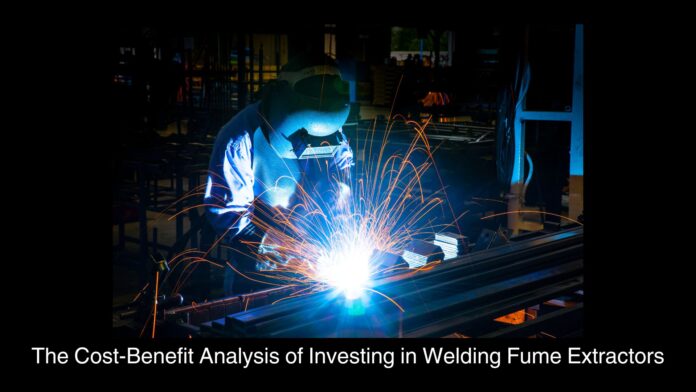Welding produces hazardous fumes that can cause severe health issues for welders over time if they consistently breathe them in. Installing proper ventilation and air filtration systems is critical for all welding shops to protect their employees. Here we will do a cost-benefit analysis of adding welding fume extractors to see if the investment pays off.
The Problems of Welding Fumes
The intense heat of welding causes the base metal and filler materials to release dense plumes of potentially toxic smoke and gases. If inhaled regularly, these fumes increase welders’ risk of developing lung conditions like bronchitis, emphysema, and pneumonia. The particulates and gases interact with lung tissue, causing inflammation and scarring over time.
The fumes also contain heavy metals like manganese, chromium, nickel, cadmium, and lead. Long-term exposure, even at low levels, can lead to neurological damage and other chronic health issues. Providing proper ventilation is not just good business practice – in many places, it’s required by law.
The Benefits of Fume Extraction Systems
High-quality welding fume extractors actively capture dangerous fumes at the arc using airflow and filtration. They provide these main benefits:
- Improve shop air quality: Extractors remove over 95% of airborne welding fume particulates, dramatically improving breathing conditions.
- Reduce respiratory risks: With harmful contaminants eliminated, welders’ risks of lung disease, metal fume fever, and other problems drop substantially.
- Compliance with regulations: Laws like Workplace Exposure Limits often mandate keeping welding fumes below a specific threshold. Extractors help meet these safety rules.
- Increased welder productivity: Better breathing conditions reduce fatigue, headaches, and other symptoms that can hamper workload and quality.
- Worker recruitment/retention: Providing a cleanly, safe shop environment shows workers you value their long-term health. This supports retention and helps attract talent.
Cost Considerations
Of course, specialized equipment like fume extraction systems requires major investment:
- Equipment purchase: Professional-grade systems range from $1,000 to $5,000 to buy initially, depending on the extractor CFM rating required. Some last 5-10 years if maintained properly.
- Installation: Paying welding engineers to integrate the extractors with shop ventilation adds $500 to $2,000+ to costs. The complexity of installation depends on the shop size and layout.
- Operation: Keeping extractors running during all welding operations increases electric bills by up to about $200 monthly for a medium-sized, busy shop. Filter cleaning and changes are also occasionally needed.
- Maintenance: To keep extractors working at peak efficiency, yearly maintenance checks by qualified technicians generally run $200 to $500. This helps prevent unexpected downtime.
Calculating the ROI
While clearly not inexpensive, welding fume extractors pay for themselves in the long run by dramatically improving shop conditions and protecting welder health. This supports higher productivity and retention.
Exact return on investment timelines vary widely based on shop size, welder salaries, electric rates, and other factors. However, here is one example ROI scenario for a small shop with two full-time welders:
- Initial equipment investment: $3,500
- Installation expense: $1,500
- Increased electric costs: $2,400/year
- Maintenance fees: $300/year
Total Yearly Operating Costs: $4,200
Now, studies show properly ventilated welders are approximately 10% more productive than those breathing fumes. If the average welder salary is $45,000:
- Extra productivity per welder: $4,500 value/year
- Total yearly productivity value: $9,000
By this math, the fume extractors system would pay for itself in the first year of use through increased productivity. And this doesn’t account for the huge savings from reducing long-term healthcare issues.
Maximizing the Value
To make the most out of a fume extraction investment:
- Get multiple bids: Prices can vary widely between models and suppliers. Shopping around is wise.
- Choose the right CFM level: Undersizing leads to inadequate filtration, while oversizing wastes electricity. Consult an expert to match CFM to your shop.
- Properly maintain: Replacing filters as needed and addressing any mechanical problems prevents breakdowns.
- Train staff: Ensure everyone understands how to use the equipment properly to maximize air cleaning.
Providing welders a clean, safe working environment should be a top priority for every shop. And as the above shows, putting inquality fume extractors has major financial upside in boosting productivity beyond just the health benefits. While not inexpensive, it’s a high return investment that indicates you truly care about your loyal employees.
Get Targeted Extraction with Tranasls All-in-One Welding Torches
One innovative product helping shops maximize fume capture efficiency is from Tranasls—a leading torch and extractor manufacturer for over 60 years. Their new line of ventilated welding torches come with builtin mini-extractors that actively capture up to 98% of hazardous particles as the torch operates. This promotes far cleaner air than relying just on ambient shop filtration. The integrated extractor and ergonomic torch handle also help reduce welder fatigue and discomfort that can decrease productivity. With different models for MIG, TIG, plasma cutting, and micro welding, Tranasls makes getting targeted extraction right at the arc simple. And their proprietary filter technology keeps initial purchase costs and maintenance expenses lower than traditional overheard extractors for many shops. Companies serious about maximizing welder health while also keeping productivity up would do well to take a hard look at these innovative integrated torches with built-in fume collection from Tranasls.


















